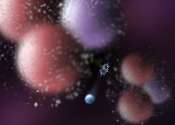In particle physics, bosons are subatomic particles that obey Bose–Einstein statistics. Several bosons can occupy the same quantum state. The word boson derives from the name of Satyendra Nath Bose.
Bosons contrast with fermions, which obey Fermi–Dirac statistics. Two or more fermions cannot occupy the same quantum state.
Since bosons with the same energy can occupy the same place in space, bosons are often force carrier particles. In contrast, fermions are usually associated with matter (although in quantum physics the distinction between the two concepts is not clear cut).
Bosons may be either elementary, like photons, or composite, like mesons. Some composite bosons do not satisfy the criteria for Bose-Einstein statistics and are not truly bosons (e.g. helium-4 atoms); a more accurate term for such composite particles would be "bosonic-composites".
All observed bosons have integer spin, as opposed to fermions, which have half-integer spin. This is in accordance with the spin-statistics theorem which states that in any reasonable relativistic quantum field theory, particles with integer spin are bosons, while particles with half-integer spin are fermions.
While most bosons are composite particles, in the Standard Model, there are six bosons which are elementary:
Unlike the gauge bosons, the Higgs boson and Graviton have not yet been observed experimentally.
Composite bosons are important in superfluidity and other applications of Bose–Einstein condensates.









